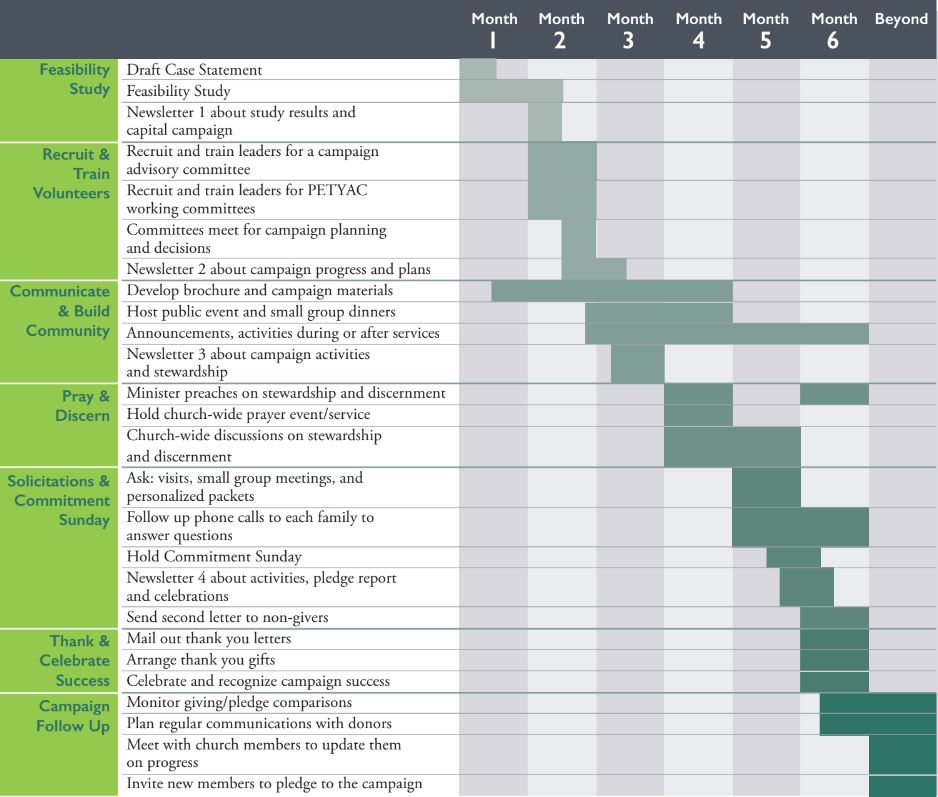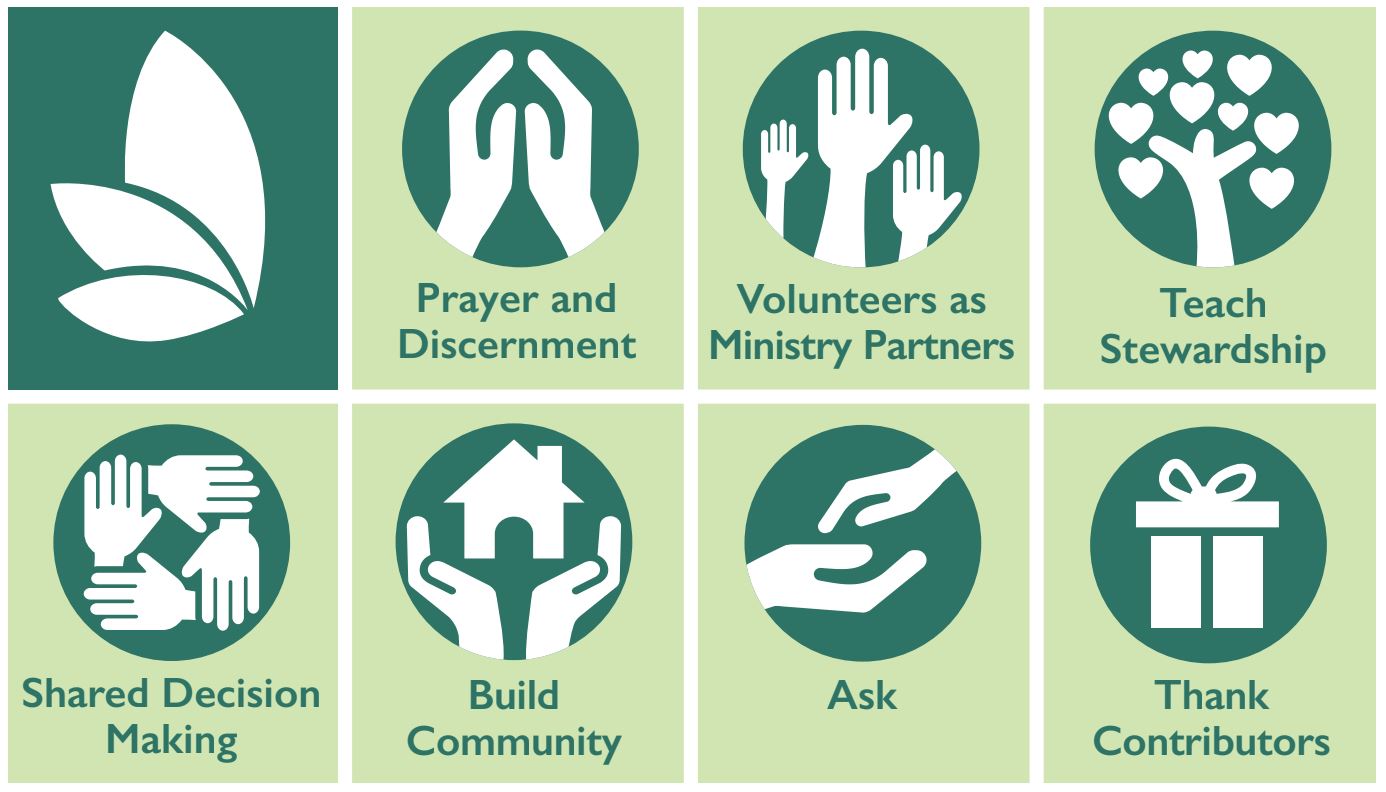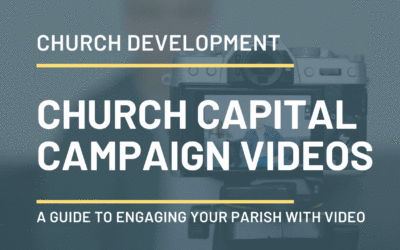What is a capital campaign in a church?
A church capital campaign is a time-limited community project to raise significant funds for a particular cause, often a new building, renovation, or debt payoff. Capital campaigns differ from fundraising in that the financial goal is often multiple times the annual amount given to the church.
How is a church capital campaign different from a nonprofit capital campaign?
A capital campaigns in a church is different from secular non-profit capital campaigns in many ways. Among the most important are the high level of sensitivity required and the engagement possibilities.
The church is a place of deep, personal encounter with God, and therefore activities conducted in the church must be sensitive to the sacredness of the relationship between God and the person.
Capital campaigns that sacrifice this sensitivity for financial gain miss the point and do damage.
What is the purpose of a capital campaign?
Conducting a capital campaign has obvious financial benefits. While these benefits may be the central motivating factor for churches pursuing capital campaigns, the money and the facilities become a pleasant side-effect of a
campaign when the campaign is done right. The most valuable outcome is the spiritual benefit to the community and its members. That said, there are of course many sound financial reasons for conducting a capital campaign including raising funds for a new building, a renovation, deferred maintenance, or debt elimination.
While a Capital Campaign is certainly a major undertaking, churches often experience a number of benefits. A capital campaign often:
- Provides funding for building and ministerial needs
- Builds community in the congregation
- Fulfills the desire of all to be stewards of their faith
- Allows people to invest at a spiritual, material and community level
- Increases annual giving
- Shows the wider community that you have a dynamic church worth joining
- Eases internal boundaries within the congregation
- Increases volunteering
- Fosters spiritual growth
- It can be fun
How long do capital campaigns last?
The active “working” phase of a capital campaign often lasts 4-6 months, with the pledging period lasting for 3 years.

How do you run a church capital campaign?
Not all capital campaigns are created equal. When working in the church, success takes a different approach from the secular fundraising world, and a spiritual understanding of the effort. As you are getting started with a church capital campaign, follow the steps below and you’re on the track to be successful.
Step 1: Conduct a Feasibility Study
A pre-capital campaign feasibility study offers church leaders a deep understanding of church members. In addition to measuring the likely levels of financial commitments, a feasibility study identifies a congregation’s support for the church, church leaders and the proposed capital campaign. A feasibility study also provides a vital avenue for members to share and dialogue about the church community and the possibility of a campaign. Read more about the benefits of a feasibility study.
It’s recommended (and often required!) by denominational leaders to do one of these studies before you start your fundraising. We recommend you hire a professional who has experience with the right questions to ask and knows how to analyze the resulting data. Your research partners should provide tailored, comprehensive data, as well as a summary of findings, to allow your leadership to set realistic goals while capturing the valuable opinions and desires of church members.
Step 2: Pray and Discern God’s Will
A capital campaign at a church should differ dramatically from most traditional or secular approaches to fundraising. This work in a church should position internal spiritual reflection and discernment as paramount, not as an afterthought. Your campaign should encourage church members to pray about stewardship and grow in understanding of the blessings the have been given.
It is pivotal that the pastor and volunteers design a time and method to engage church members in prayerful discernment regarding the church’s vision and capital campaign, helping to build community and growing a church’s understanding of stewardship.
Our church capital campaign management services emphasize prayer over pressure.
Step 3: Educate on Stewardship
A capital campaign invites church members to heed God’s call and explore their personal understanding and commitment to stewardship through numerous activities. We see so many of our client’s church communities grow stewardship, create a stronger sense of spiritual awareness and a clearer shared vision for the life of their church.
Many churches we’ve worked with report that after a stewardship-based capital campaign, church members deepen their financial commitment to annual giving, become more active and attend services more regularly. Growing stewardship and building community are two of the most powerful results from stewardship education during a campaign.
Step 4: Engage Volunteers
It is essential that you establish multiple teams within the church to envision, plan and execute a capital campaign. These teams focus on general oversight, prayer, education and stewardship, thanks, youth events and communication throughout the capital campaign. It can be helpful to work with professional consultants to train, organize and serve as a resource to each group of volunteers, supporting their work and sharing the load over the course of the entire campaign process.
Step 5: Communicate!
Throughout a campaign, church members should have frequent opportunities to deepen their understanding of the church’s vision and purpose for undergoing the campaign process. Effective communication tools, like newsletters, brochures and interactive campaign activities throughout the campaign help to accomplish this goal. You want to present these in a visually appealing manner that hits the basics without be overwhelming.
Consider infographics and photos of campaign events. Church members should be kept abreast of the church’s vision and campaign purpose from the very start of a campaign following through to the very last pledge payment. Transparency is key! We offer a free downloadable guide to your campaign communications.
Step 6: Solicit Pledges
Each church is distinct. As such, no single right way exists to solicit donors. The volunteer team responsible for stewardship education should tailor a solicitation process that is comfortable to church members. Who should reach out? Where/how should they meet? Are there specific and tailored materials for your top donor prospects?
Research and experience show that a reflective and involved decision to invest in a faith community fills people of faith with a true sense of being a steward. The result of your intentionality with this can be the difference between hitting and missing your campaign goal. Consider how you will present your pledge card or online giving options to make it easy for people to participate.
Step 7: Thank Donors and Celebrate Success
All good fundraising entails appropriate celebration and thanks. Volunteers on the “thanks” team determine how the church will recognize donors and celebrate the achievements of the capital campaign. A unique, meaningful gesture of gratitude, like a thank you note, for those in your community can go a long way in cultivating ongoing support for the full extent of your pledging period.
Thoughtful campaign follow-through bolsters the culture of stewardship that will carry on into your annual appeal and far beyond!
Do you need some specifics on how to implement this approach? Check our our webinar on the topic and then download our comprehensive e-book on how to run a stewardship-based church capital campaign. It’s everything you need to know about how to be successful in your fundraising efforts without all the fundraising.

What makes a successful capital campaign?
The success of any church capital campaign hinges on 3 major factors.
- Support from the pastor
- Input and buy-in from the parish/congregation
- And campaign leaderships’ acceptance of the reality that….
In order to raise funds you must spend funds.
Here are ten more considerations to ensure that your campaign is a success before it even begins:
- Pray together for God’s will to be done
- Involve the parish in the planning process
- Articulate the need for a campaign
- Select a campaign chairperson(s) who is articulate, committed, and respected
- Investigate hiring a capital campaign consultant for some level of assistance
- Conduct a feasibility study
- Create a visual representation of a building or renovation
- Build the congregation’s commitment to the campaign
- Identify staff who will work on the campaign
- Convey the vision of the spiritual and material aspects of the project
How often should you have a capital campaign?
On average, a church is ready for a capital campaign every 5 years. That being said, discernment of the right time is crucial.
When done well, church capital campaigns are cyclical in nature. Once one campaign is completed, it may very well be time to start thinking about the next one. But subsequent campaigns require creative thinking and new ideas to continue engaging members in a meaningful way.
Once you’ve completed your first campaign, and you are a couple of years into the commitment payment period, it is a good idea to begin planning for the next campaign. Most churches that use the Church Development model for a capital campaign are eager to begin planning for subsequent campaigns, and this is usually because they found the campaign to have so many community-building and spiritual benefits for the congregation. Conducting a capital campaign every five years is a proactive way to provide for the church’s needs beyond regular operations, without financially overextending members.
Second (and subsequent) campaigns present a different set of challenges than first campaigns do. You must come up with new ideas and do things differently the second time around. Second campaigns require that you step up the intensity level; even with added intensity, you will most likely raise about one-third less money than you did in the first campaign.
How much can a church expect to raise in a capital campaign?
Congratulations! You’ve asked the million-dollar question. The answer is as varied as the pastors who ask it.
That being said, some trends can give a general idea. On average a church capital campaign raises about 250% of annual, unrestricted giving to the parish. New building and renovation campaigns are exciting for parishioners and often raise more. Debt elimination is more challenging and often raises a little less. These averages are achieved when the community is involved and engaged in the campaign process and a professional consultant manages the campaign.
Churches who choose not to hire a professional typically raise between 50%-150% of annual giving, and end up with a burnt-out staff and frustrated parishioners. This is why nearly every Catholic Diocese in the U.S. and most other denominational leaders recommend (or sometimes require) hiring a professional capital campaign consultant.
%
of Annual Giving (Average)
How much should a capital campaign cost?
How much should I budget for a capital campaign?
It’s unrealistic to think that you can raise $1,000,000 without spending $1.
What do capital campaign consultants do?
Capital campaign consultants provide strategic guidance and sometimes management of campaign execution. They tailor the campaign to fit the unique situation and goals of the parish. Importantly, they help to pivot and think creatively to solve problems when the campaign doesn’t go as smoothly as hoped.
Church Development consultants meet with the pastor, church administrator, and campaign Leadership Team on a weekly or biweekly basis to plan and monitor activities. The consultant also interacts with team leaders regularly to ensure teams are on track and maintains lists of tasks, responsibilities, and completion dates to ensure quality control.
Why hire a capital campaign consultant?
How much does a capital campaign consultant cost?
Feasibility study fees vary greatly from firm to firm. They can range from $6,000 to $25,000, depending on the scope of the study, the number of people interviewed and the size of the church.
Consultant fees vary a great deal as well. You could solicit bids from various firms, they will likely range from 3-10% of the campaign budget, (although the fee should be a set amount, not a percentage of funds raised per ethical standards of the AFP).

Stewardship-Based Church Capital Campaigns eBook
We've written a comprehensive eBook to be your guide. Download to learn more than you ever wanted to know about running a church capital campaign.

